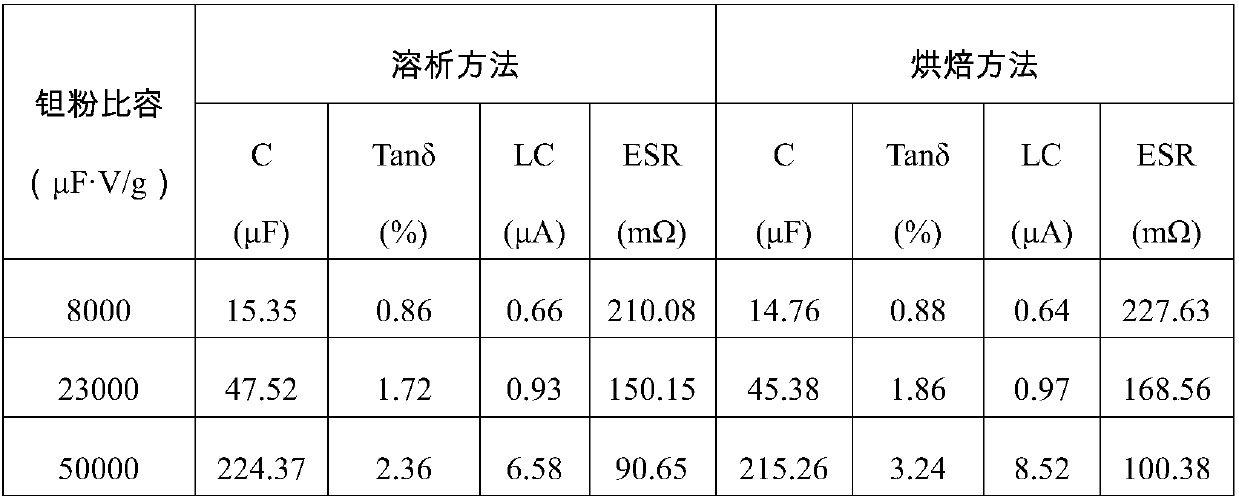Method for removing adhesive in anode block of solid electrolytic capacitor
A technology of solid electrolysis and adhesive, which is applied in the manufacture of solid electrolytic capacitors, electrolytic capacitors, and electrolytic capacitors. Improved stability and reliability effects
- Summary
- Abstract
- Description
- Claims
- Application Information
AI Technical Summary
Problems solved by technology
Method used
Image
Examples
Embodiment 1
[0031] A method for removing the binder in the anode block of a solid electrolytic capacitor, comprising the following steps:
[0032] (1) Dissolving: mix the adhesive with the solvent and put it in a blender to stir for 2 hours until the adhesive is completely dissolved to obtain a solution;
[0033] (2) Spraying: Spray the solution on the surface of the tantalum powder, and stir while spraying to obtain a mixture;
[0034] (3) Drying: put the mixture in an environment of 20°C and dry for 20 minutes to obtain powder;
[0035] (4) Molding: Pour the powder into a molding machine and press into a molding machine to obtain a tantalum billet;
[0036] (5) Shaking sieve: place the tantalum billet in the sieve and shake it for 3 minutes until there are no particles or dust particles in the sieve;
[0037] (6) The first dissolution: After shaking the sieve, immerse the sieve together with the tantalum billet into the A-type solution for dissolution, and rotate during the dissolutio...
Embodiment 2
[0051] A method for removing the binder in the anode block of a solid electrolytic capacitor, comprising the following steps:
[0052] (1) Dissolving: mix the adhesive with the solvent and put it in a blender to stir for 4 hours until the adhesive is completely dissolved to obtain a solution;
[0053] (2) Spraying: Spray the solution on the surface of the tantalum powder, and stir while spraying to obtain a mixture;
[0054] (3) Drying: put the mixture in an environment of 100°C and dry for 300 minutes to obtain powder;
[0055] (4) Molding: Pour the powder into a molding machine and press into a molding machine to obtain a tantalum billet;
[0056] (5) Shaking sieve: place the tantalum billet in a sieve and shake it for 5 minutes until there are no particles or dust particles in the sieve;
[0057] (6) The first dissolution: After shaking the sieve, immerse the sieve together with the tantalum billet into the A-type solution for dissolution, and rotate during the dissolutio...
Embodiment 3
[0071] A method for removing the binder in the anode block of a solid electrolytic capacitor, comprising the following steps:
[0072] (1) Dissolution: mix the adhesive with the solvent and put it in a blender to stir for 3 hours until the adhesive is completely dissolved to obtain a solution;
[0073] (2) Spraying: Spray the solution on the surface of the tantalum powder, and stir while spraying to obtain a mixture;
[0074] (3) Drying: put the mixture in an environment of 80° C. and dry it for 220 minutes to obtain powder;
[0075] (4) Molding: Pour the powder into a molding machine and press into a molding machine to obtain a tantalum billet;
[0076] (5) Shaking sieve: place the tantalum billet in a sieve and shake it for 4 minutes until there are no particles or dust particles in the sieve;
[0077] (6) The first dissolution: After shaking the sieve, immerse the sieve together with the tantalum billet into the Class A solution for dissolution, and rotate during the diss...
PUM
 Login to View More
Login to View More Abstract
Description
Claims
Application Information
 Login to View More
Login to View More - R&D
- Intellectual Property
- Life Sciences
- Materials
- Tech Scout
- Unparalleled Data Quality
- Higher Quality Content
- 60% Fewer Hallucinations
Browse by: Latest US Patents, China's latest patents, Technical Efficacy Thesaurus, Application Domain, Technology Topic, Popular Technical Reports.
© 2025 PatSnap. All rights reserved.Legal|Privacy policy|Modern Slavery Act Transparency Statement|Sitemap|About US| Contact US: help@patsnap.com

